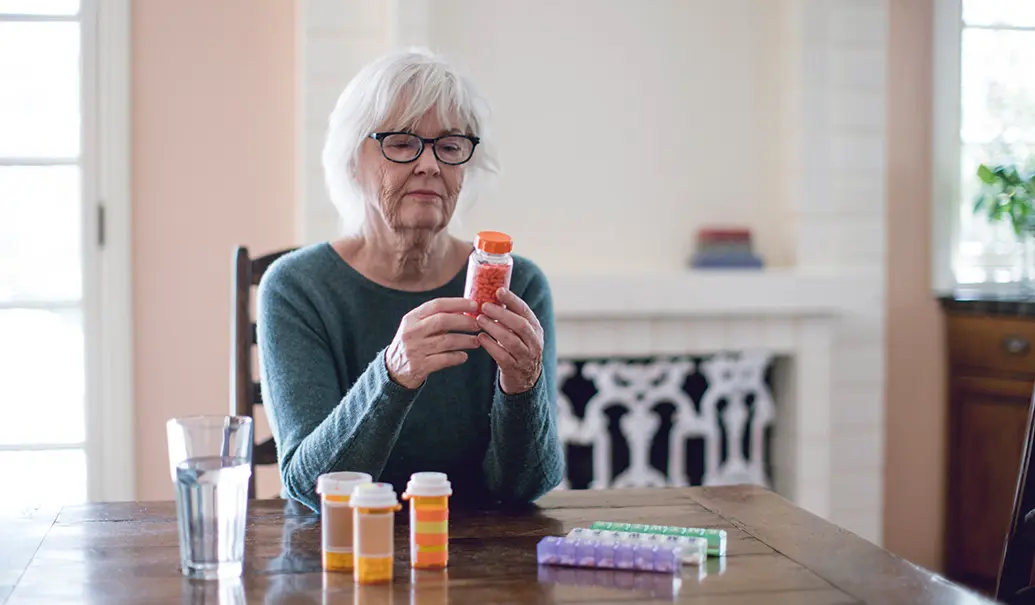Nonadherence to medication—not filling prescriptions, skipping doses, splitting pills—is associated with poor patient health outcomes and contributes to high healthcare costs. But why is it such a key area of concern for life sciences companies and why do they invest so heavily in patient support programs aimed at improving medication adherence?
- The commercial bottom line: Since patient adherence affects how much a patient will consume from the time of initial therapy start, it directly impacts the sales dollars a product can generate. In short, nonadherence can lead to a significant loss in revenue.
- Quality of life and health outcomes: Adherence plays a major role in a patient’s health and has been consistently linked to disease prevention. Dose adherence—often regardless of which specific medication or therapy the patient uses—is a direct factor in the control of the symptoms experienced by patients and often in the progression of their disease.
While it’s well known that adherence to chronic medication is imperfect, relatively few cross-therapeutic area comparisons of medication adherence have been conducted to date. Benchmarking medication adherence across a wide range of therapeutic categories can provide insight into which product characteristics drive patient adoption across diverse markets, produce archetypes for new product launches, measure brand performance (such as adherence versus best-in-class) and inform forecast assumptions.
ZS computed benchmarks for more than 35 products across nine therapeutic categories, specifically selected to capture a broad patient population across a range of common chronic conditions. Analysis was conducted using Optum’s de-identified claims dataset from January 2014 to June 2019.
| Therapy Area | Drugs |
|---|---|
| Anti-epilepsy | Vimpat, gabapentin, lamotrigine, topiramate, levetiracetam |
| COPD | Breo Ellipta, Spiriva, Spiriva Respimat |
| Cardiovascular disease | Crestor, Lipitor (branded and generics) |
| HIV | Biktarvy, Truvada, Juluca, Triumeq |
| Multiple sclerosis | Copaxone, Gilenya, Tecfidera, Ocrevus, Tysabri |
| Psoriasis | Cimzia, Humira, Otezla, Remicade, Xeljanz, Tremfya |
| Rheumatoid arthritis | Cimzia, Humira, Remicade, Xeljanz |
| Severe asthma | Fasenra, Nucala, Xolair |
| Type-2 diabetes | Farxiga, Humalog, Invokana, Jardiance, Levemir, Trulicity, Victoza |
How does persistency measure up by therapy area?
How does compliance measure up by therapy area?
How do various drugs perform in the market?
Across the categories we examine, the leader in adherence metrics isn’t necessarily the overall leader in patient share, suggesting that strong performers in adherence have differentiated dosing, tolerability profiles or other factors which enable better patient adherence versus the standard of care.
This proves true with multiple sclerosis, where the first-to-market leader in patient share doesn’t lead in patient adherence. Copaxone is the leader in patient share and the first product to market considered in our analysis, launching in September of 1996. Gilenya, which launched four years later, has the best overall adherence metrics and presents patients with a once-a-day oral therapy option in contrast to Copaxone’s injections, which are administered daily or three times a week.
In other markets, the adherence leader is distinguished by overall convenience of the dosing regimen. In HIV, adherence leader Biktarvy combines three agents into the same fixed-dose combination, eliminating the need for patients to manage separate prescriptions. Compare this to the same manufacturer’s earlier product, Truvada, which is always taken in combination with another HIV medication and led in market share while having the lowest adherence rates. In the anti-epilepsy market, adherence leader Vimpat requires only twice-daily oral administration while patient share leader gabapentin requires three times daily oral administration. Again, leading in patient share doesn’t mean leading in adherence.
We also find that maintenance dosing schedules that reduce the total number of doses needed achieve higher adherence than therapies that have a more frequent fixed-course schedule. Take rheumatoid arthritis (RA) and psoriasis, for example. Remicade presents patients with the option of three starter doses, followed by one maintenance dose every six weeks. In contrast, Humira has a more frequent schedule of once every other week, and trails Remicade in most adherence metrics. Similarly, in severe asthma, Xolair trails Fasenra in adherence and requires 13 and 26 injections annually[JB1] , compared to only eight for Fasenra. In these examples, the maintenance dosing schedule gives the adherence leader an advantage in the overall drug burden a patient incurs.
This data can have a major impact on pharma organizations’ bottom lines. The lowest performer in patient compliance, gabapentin, is also the leader in overall patient share. Without adjusting for dose titration, if the 11% gap between gabapentin’s average medication possession ratio (MPR) and the market average were closed, it would amount to as many Rx’s as are observed for two of its competitors in total. In HIV, Truvada has the lowest average MPR but the largest claim and patient share during the observation period. If the 14% gap between Truvada’s average MPR and the market average were closed, using a cost assumption of $1,842 per bottle, it would amount to an additional $69 million in revenue over the observation period, just for the portion of market activity which is captured in the claims sourcing.
Type 2 diabetes and cardiovascular disease each present additional considerations when measuring adherence. Type 2 diabetes is divided into therapies indicated for patients who have become insulin dependent and those who are pre-insulin dependent. Thus, the significantly lower adherence rates of home injection insulin therapies aren’t easily compared with those of pre-insulin therapies, because they represent a more advanced and chronically ill patient type within the same disease state.
We observe strong adherence across multiple longer-acting products of both oral and injectable administration routes for pre-insulin-dependent therapies, including Invokana and Jardiance, both once-a-day SGLT-2 therapies, as well as Trulicity, a once a week injectable GLP-1. Humalog and Levemir, which are used by patients whose disease state has advanced to insulin dependence, have much lower adherence.
In the cardiovascular market, it’s possible to observe lower adherence rates in branded formulations in comparison to generic formulations of the same compound. Crestor went off-patent July 31, 2016, and branded Crestor has better adherence than the generic product in each metric that was considered, with a six-month persistency rate of 33% for the branded product compared with 14% for generic, and an average fixed MPR of 61% for branded compared with 55% for generic. This trend again suggests that higher cost may be a driver of persistency and compliance, as patients are more likely to adhere to medications that they’re more invested in financially.
How does disease severity impact adherence?
While it isn’t true across the board, due to the complexities of how therapeutic options and disease characteristics vary from market to market, we generally observe that chronic and severe disease states have higher rates of patient adherence while chronic but less severe diseases have lower overall adherence due to the higher stakes involved if a patient neglects a medication. Additionally, in serve markets with commercially competitive, innovative therapies which are valued at a premium, adherence was higher than in other markets where generic formulations are widely available and patients are less financially invested in their therapy choices.
HIV, for example, has distinctively high patient adherence, with an average six-month persistency rate (64%) that is 20% higher than the market average and an average fixed MPR of 85%, almost 20% higher than the market level average MPR of 66% for fixed-course markets. Two other chronic markets, RA and psoriasis, which share many of the products, have six-month persistency rates that are about 15% higher than the overall rate of other markets. The average cost of medication for biologics in RA, psoriasis and anti-HIV drugs are higher than in other markets, with average wholesale acquisition cost prices ranging from hundreds to thousands of dollars per unit.
Less severe chronic markets type 2 diabetes and cardiovascular disease have mixed to poor adherence. Type 2 diabetes performes moderately, with an average fixed MPR of 68% and an average six-month persistency rate of 48%. And in the cardiovascular market, the branded and generic statins present poor persistency with an average six-month rate of 27%. The low rate of persistency may be partially attributable to switching between statins, a question that isn’t explored in the product level methodology. It’s possible that statin patients have low adherence when measured for an individual product, but greater adherence when measured across statins irrespective of brand or molecule. Drug class level persistency in markets like cardiovascular, which have class level competition between products with similar profiles, is an area of interest for future extensions.
Out of the therapeutic areas considered in the analysis, patient adherence is predictably the lowest in markets characterized by intermittent disease episodes because regular drug use isn’t a part of the treatment guidelines or appropriate for the disease state. COPD and anti-epilepsy, disease states in which patients have acute exacerbations and seizures, respectively, have the lowest adherence figures. COPD has an average fixed MPR that is 48 to 18% percent lower than the average for fixed-course markets, and the average six-month persistency rate of COPD is only 20% less than half of the overall average rate of other markets. Anti-epilepsy has an average six-month persistency of 30%, almost 15% below that of other markets.
What does this mean for life sciences companies and for patients?
Regardless of the market specific nuances at play, patient adherence affects pharmaceutical companies’ commercial bottom line, no matter the product’s overall share of patients in a given market. Each patient presents a total opportunity for life sciences companies to sell them their product—and continue selling it to them—for as long as that patient needs treatment. Therefore, if the patient isn’t persistent or compliant, the company loses out on part or all of that opportunity. To put the value into context, if each product with the lowest MPR rate in its respective market were to improve patient compliance to the level of its respective average market rate, these underperformers would increase their dispensed quantity and associated revenue by an average of 10%.
Beyond its commercial value, medication adherence has been consistently linked to disease control and improved patient outcomes. In a study published by the World Health Organization, medication adherence can have a greater impact on patients’ outcomes than the choice of the specific treatment. Understanding the factors in successful adherence programs and top adherence leads not only to the realization of the full potential of a commercial product, but also to the patient’s health outcomes and quality of life.
Add insights to your inbox
We’ll send you content you’ll want to read – and put to use.















